
WITH this page, I am proposing/inaugurating a new Forgotten NY series, Greatest Hits, that will be appearing periodically, much like the series began earlier in 2024, One and Done, concerning NYC’s one-block streets; I got through Manhattan in three parts, though the other boroughs will be a bit longer, and for (relative) brevity’s sake, I’m leaving out one-block bits of numbered streets in each borough.
The premise of Greatest Hits is simple. I will take a neighborhood and visit the infrastructural items in each that intrigue me and capture these items with more photographic attention than I have devoted previously, shooting where possible from many different angles and focusing on detail I had not noticed before. While some of the items discussed have been mentioned in Forgotten NY (repeatedly) before, the website is now 25 years old, some are “late to the party.” What I consider a site weakness, and one that has been intractable thus far, is that pages I have written years ago are hard to find unless one gets really specific using the site function. In short that means I’ll be repeating some copy written before, but at the same time providing new comments where appropriate.
Flushing seems a good place to start, as while it’s one of NYC’s most crowded and bustling regions, infused with immigrations from South Asia beginning 40 years ago, it’s a very old town founded in the 1600s and chockfull of historic relics.
When I shot Part One, April 13. 2024, the weather was not optimum for photography, dull and overcast, and I cut things short due to impending showers. Returning to Flushing on May 18th, conditions were much better with mostly sunny with some passing cumulus. I got 113 photos, and my time is limited on weekends now with work I do for Marquis Who’s who and the need to get out and shoot more scenes, so I may have to cut this short and finish in Part Three; we’ll see.
St. George’s
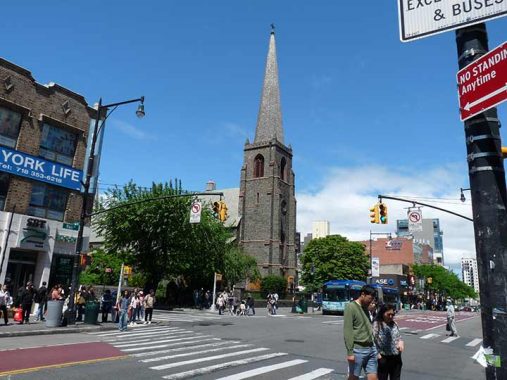
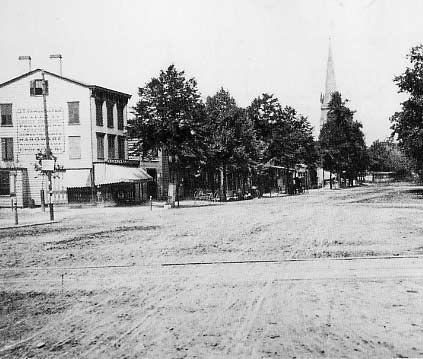
In 1870, Flushing, which was then already over 200 years old, was still a one-horse town and there’s nary a horse to be seen, although you can make out wagon wheel tracks in the dirt road. We’re at what is now the intersection of Main Street and Roosevelt Avenue — now one of the most insanely crowded crossroads in a city full of them.
The only constant between then and now is the presence of St. George Episcopal Church, founded in 1702. The present church is the third on the site, constructed from 1853-1854.
The third and present church occupies the same site as the original building and was built from 1853-54. It was designed by Frank Wills and Henry Dudley, architects associated with The New York Ecclesiological Society that had an interest in the development of Gothic Architecture as a new style (Neo-Gothic) for American churches. Local craftsmen were engaged and regional materials were used. The building includes walls of randomly laid granite rubble, fine stained glass windows. Above the entrance is a 150-foot tapered stone tower that houses a bell recast at Troy, N.Y., using the 1760 bell’s metal and bearing the inscription, “The gift of John Aspinwall, Gentleman, 1760.” American Guild of Organists
The steeple seen on the church today is at least the second in the 1854 church’s existence. In September 2010 a derecho, or hurricane-force gust of wind, blew the steeple down to Main Street. Fortunately the funds were found for an exact replica.
St. George has two churchyards in which congregants were laid to rest. One is easily entered via the front gate on Main Street (frankly it’s now a bit overgrown) and the other one is behind a locked gate on 38th Avenue west of Main Street.
Stones in churchyards can be much older than the church building itself, if the church has been rebuilt several times over the years. St. George’s churchyard bears stones with names now found on Queens maps, such as Lawrences, Pecks, and Cornells.
If only St. George Church could talk and tell what it has seen on Main Street over the years. Here’s a look at what faces it on Main Street in 2024, and the Garret Garretson Homestead, which was directly across the road from the church from 1659 (predating the Bowne House) until 1911. For many years the Garretson family, Dutch in origin, were employed by the William Prince plant nurseries. (A common Dutch naming scheme was naming sons after fathers, and appending the “-son.” According to that scheme, I could be a Kevin Kevinson).

It’s getting so I’m surprised to find a building in downtown Flushing that’s either not very old or very new. FDNY EMS Station 52 on 39th Avenue, formerly Engine 277, was built in the 1925-1935 date range from the looks of things.
Spicy Palace, 38th Avenue and Prince Street, has some interesting scenes from the old country as exterior artwork.
Ebenezer Missionary Baptist Church (now Queens Baptist Church), Prince Street between 36th Avenue and 36th Road, is one of the oldest African -American churches in New York City. It was founded in 1870, with the present building erected in 1919. The longtime pastor was Dr. Timothy P. Mitchell, who worked closely with Dr. Martin Luther King. He is remembered on the cornerstone of an adjoining newer church building and on a newly installed street sign.
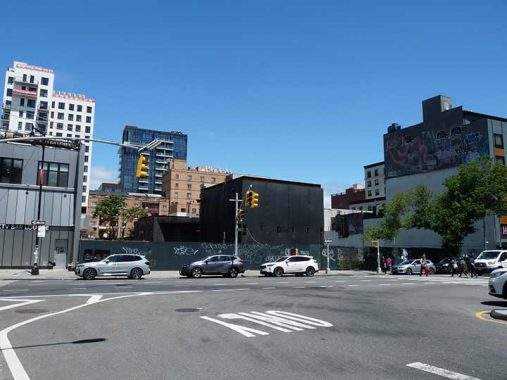
An empty lot, with a mysterious black box (anyone watch “Dark Matter” on Apple TV?) has replaced RKO Keith’s Theater at Northern Boulevard and Main Street. RKO Keith’slay empty at the head of Main Street at Northern for over 30 years, resisting all attempts to restore or renovate it; indeed, a previous owner, developer Tommy Huang, gutted much of the lobby. A recent plan to make it a shopping mall, while retaining its grandiose lobby, stalled and the site is now supposed to be redeveloped. The theater was built by prolific theater architect Thomas Lamb in 1928. Vivid accounts of what this great landmark once looked like, and what became of it, can be found at cinematreasures.
One of NYC’s few Spanish-American War memorials is this flagpole at Main St. and Northern Blvd. The park behind it, in the middle of Northern Bouelvard between Main Street and Linden Place is named for Daniel Carter Beard, father of the American Boy Scouts. Beard’s name also graces one of the uglier buildings in Flushing, the Daniel Carter Beard School, on Sanford Avenue and 147th Street, one of a whole class of 1950s schools that appears to have been modeled on a high-security prison.
“Farrington” is an old name in Flushing and College Point; the first Farringtons arrived in Flushing in the 1640s. Farrington Street, which now ends at the Whitestone Expressway, was formerly a main route between the two communities.
John Farrington opened a farrier and blacksmith on 14th Avenue and 126th Street in College Point 1868, and the business survived into the 21st Century through several modes of animal and mechanically- conducted transportation. I am on Facebook with Farrington family members.
Town Hall
Flushing Town Hall at Northern Boulevard and Linden Place, constructed in 1862 by a local carpenter, an example of Romanesque Revival. It is a reminder of the days before Flushing became a part of Queens and then a part of New York City. Frederick Douglass and P.T. Barnum, and at least two presidents, appeared here during the building’s heyday. After NYC consolidation in 1898 Flushing Town Hall became a municipal courthouse, but it suffered from a gradual deterioration over the decades; there were fitful attempts to turn it into an anthropological museum in the 1970s. When I first moved to Flushing in 1993 it was a rundown heap protected by chicken wire from ever-present vandals.
The story does have a happy ending. Town Hall was magnificently restored in 1995 by the architects Platt Byard Dovell and it is currently the seat of the Flushing Council on Culture and the Arts. The magnificent building is now a vibrant locale for local arts programs and jazz concerts. The Flushing Council on Culture and the Arts presents a variety of programs including teacher training workshops, rehearsals and meetings of cultural and community organizations. For information call 718-463-7700, or visit their website.
Town Hall is a stop on the Flushing Freedom Mile. Colorful and informative signs have been placed at existing Flushing historical sites, such as the Quaker Meeting House across Northern Boulevard from Town Hall, and the John Bowne House on Bowne Street. The latter two structures date to the late 1690s. Much of the hall was closed for a scheduled concert today, but I was able to take a peek at the gallery, which was exhibiting work. by local Korean artists.
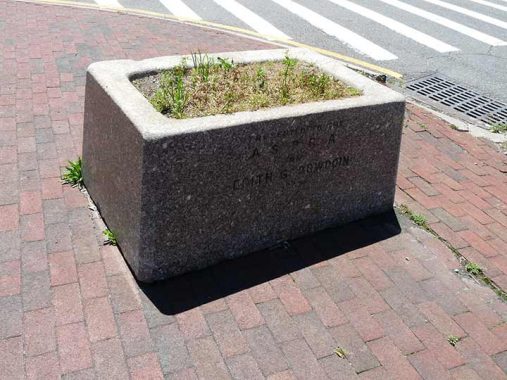
In 1909, the auto was beginning to make inroads on America’s highways. But horsepower was still pretty much the way to get around. That year, Edith Bowdoin presented this concrete horse trough to the American Society for the Prevention of Cruelty to Animals. It must have been placed on Northern Boulevard, if not that year, a long time ago. Incredibly it is still on Northern Blvd., in the center median at Union Street.
Quaker Meetinghouse
The Quaker (Friends) Meetinghouse has been used for Quaker religious services since it was constructed between 1694-1717, a span of over 300 years. Not only is the building remarkable for its great age … it also figured in one of the first shots fired in the ongoing war for religious and personal freedom that is being fought even today.
In 1657, the Dutch still were in charge of New Netherland, and Governor Peter Stuyvesant ruled with an intolerant hand. He forbade any religion but the Dutch Reformed Church of his homeland, even for English settlers who were starting to trickle in. Quaker settlers sent a letter to Stuyvesant in that year that has come to be known as the Flushing Remonstrance, that reiterated the settlers’ desire for religious freedom. The document was signed by Flushing’s town clerk and sheriff, who were not Quakers. Nonetheless, they were soon tossed into prison, then summarily fired. 37 years after the Flushing Remonstrance was presented to Stuyvesant, this meetinghouse was raised in 1694.
At the rear you’ll find a quiet churchyard with graves hundreds of years old that makes quite a rural riposte to bustling Northern Boulevard. Like the Quaker cemetery in the middle of Prospect Park in Brooklyn, gravestones are simple while markers with the name of the deceased and birth and death date at most.
At Quaker meetinghouses, as the name suggests, there are no Sunday services: but all are free to come in for silent worship or discussions with congregation members for those curious about Quakers.
The sign outside the Meetinghouse could almost be called a landmark in its own right, since it has stood here since 1936! Local youth have added their inevitable marks to modern Flushing Freedom Trail signs in some cases.
Flushing’s Armory, opened in 1905, is smallish as NYC armories go, but it is the only castle-shaped armory in Queens (a large armory in Jamaica is more Deco in construction). It has been home to the National Guard, high school proms, and the NYPD. Much earlier, in 1657, the Flushing Remonstrance (see above) was written in the farmhouse of one Michael Milner.
War Memorials
The inscribed names on the Flushing’s venerable Civil Wat memorial, an obelisk erected in 1865 opposite what would later be the Town Hall site, all of them belonging to volunteer warriors, are fading with time. One of the names is Captain William Dermody, an outspoken abolitionist who was mortally wounded at the Civil War Battle of Spotsylvania, VA in May 1864. He is also remembered at Dermody Square in Bayside Hills and at his gravesite in Mount St. Mary’s Cemetery.
The original Penn Station (1910-1964) was built from beautiful pink marble similar in appearance to what can be found at Hermon MacNeil‘s World War I memorial, in the Northern Boulevard center mall west of Union Street, bearing the names of Flushing’s dead in that conflict. MacNeil, a College Point resident, also designed the “Standing Liberty” quarter (the predecessor to today’s Washington Quarter), the Marquette Memorial in Chicago, and 4 busts in the Hall of Fame of for Great Americans, among many other works.
The memorial features The traditional Roman fasces, which consisted of a bundle of birch rods tied together with a red ribbon as a cylinder around an axe. Though adopted by Italian fascism in the early 20th Century, the symbol seems to have avoided the stigma that the swastika acquired after its adoption by the Nazis.
Before today’s colorful and informative Flushing Freedom Mile signs were installed in the 2000s, there was the Flushing Freedom Trail, marked by small red signs and by a red stripe painted on sidwalks. The stripe has disappeared but a couple of the older signs are still in place.
Latimer House
Lewis Latimer (1848-1928), inventor and engineer, was born in Massachusetts to parents formerly held in slavery in Virginia. He enlisted in the U.S. Navy in 1864 and upon his release, answered an ad for an office assistant from the patent law firm of Crosby and Gould, ascended to head draftsman, and discovered he had a knack for invention.
While still at Crosby and Gould, Latimer assisted Alexander Graham Bell, providing the drawings for Bell’s patent application for the telephone; after leaving the law firm, Latimer joined the U.S. Electric Lighting Co, a chief rival of Thomas Edison. There he would produce a long-lasting carbon filament that was a major improvement over the one used in Edison’s 1878 electric lightbulb; Edison’s filaments, which used bamboo filaments, burned out quickly, making early bulbs impractical. Latimer published “Incandescent Electric Lighting, A Practical Description of the Edison System,” an early electric lighting guidebook, and went on to develop arc lamps and cooling and disinfecting devices. Latimer also developed the first threaded lightbulb socket and assisted in the installation of New York City’s first electric streetlamps, among many other inventions.
After residing in Brooklyn for a number of years, Latimer moved his family to a small frame house on Holly Avenue in Flushing, where he corresponded with authors and educators Frederick Douglass and Booker T. Washington. By 1995, the small house, which was in a deteriorating state, was declared a landmark and was later restored to its original condition and moved to a new location at 137th and Leavitt Streets, across the street from the Latimer Houses, which were named for the inventor.
Unfortunately the Latimer House is closed on Sundays (weird!) so I had to shoot through the fence for these views. I have gotten inside on a few occasions, during Open House NY in October and in Flushing’s annual Holiday House Tour, which happens every December and I totally recommend it. In spring 2024, the house was closed while a new exhibit is added.
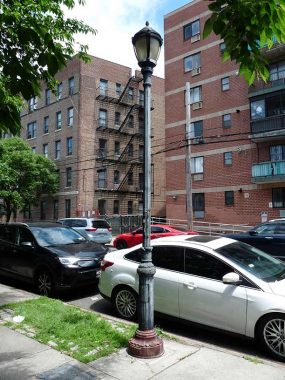
When the Latimer house was restored and opened as a museum it received a set of Type A park lamps on Leavitt Street. I like them a bit better, though, when they go unpainted for awhile and a patina of rust adds a “glow.”
Flushing High School
Flushing High is landmarked Collegiate Gothic building dating to 1915, rather resembling Shepard Hall at City College of NYC in Morningside Heights. This may be the handsomest high school campus open to the public, as the gates were open on Sunday and I found a bench for a needed breather. The high school itself was chartered in 1875 as the NYC area’s first public high school in Queens County. Over 2000 students go to school at FHS. Alumni include actor George Maharis, restaurateur to the stars Vincent Sardi, Jr., comedian Godfrey Cambridge and Fleshtones singer Peter Zaremba. whose Time Out NY‘s articles on NYC inspired my own Forgotten NY research.
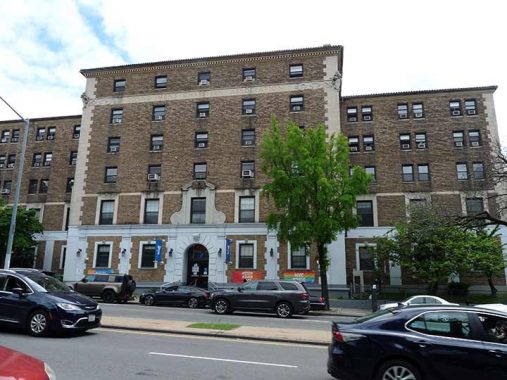
The Flushing YMCA at Northern Blvd. and Bowne Street was built in 1925. According to the YMCA website, the organization was founded in 1844 and in 1891, James Naismith invented basketball under the YMCA’s employ. You know what, I keep meaning to sign up for swim lessons at the Y. I consider it a black mark that I never learned (and most animals know how at birth). I was enrolled at the Park Slope Y at age 8, but quit when fear got the best of me. At 66… is it too late…
I have a couple of photos remaining, but it’s Sunday night and as Joe Biden says, I’ll “call a lid.” They’ll make their way to One Shot pages as time goes by.
As always, “comment…as you see fit.” I earn a small payment when you click on any ad on the site. Take a look at the new JOBS link in the red toolbar at the top of the page on the desktop version, as I also get a small payment when you view a job via that link.
6/2/24

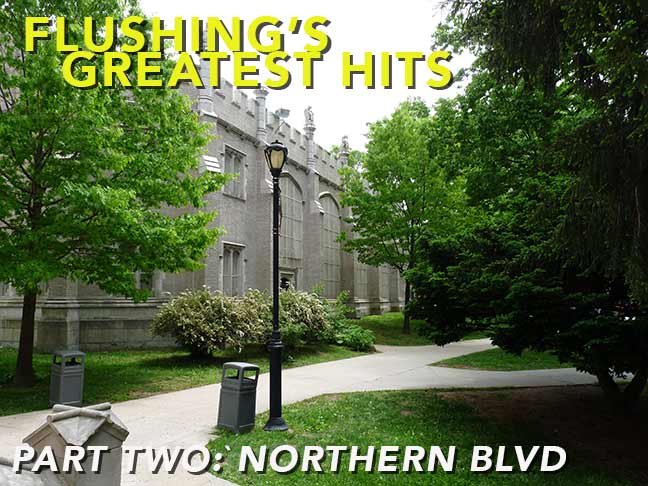

7 comments
From 1974-78 I lived within walking distance of Flushing Town Hall. Around 1976 or so it became a dinner theater; the theater was at ground level & the restaurant was on the second floor. They offered subscriptions for the season. After about two or three plays the dinner theater quietly closed. It was a noble attempt but in those years Broadway was affordable, especially since there was a two-for-one policy at the ticket counter at Times Square & the Broadway plays were much better. So much for fond memories of my early adulthood.
At least St. George’s fared better than the church in Connecticut whose steeple fell earlier this year. It fell onto the church and destroyed it.
You don’t see many Spanish-American War memorials because the leading cause of death was not combat but poisoning from improperly canned foods.
You’d have figured malaria, or yellow fever?
I remember that, back in the 1950’s or so, there was a beautiful eagle finial atop the Spanish-American War Memorial. Somewhere along the way it disappeared. I also recall, but am not sure if I am correct, that some part of the memorial came from the Battleship Maine.
In 1927, Rex Cole was the exclusive agent for General Electric refrigerators in Queens. From then, until a few years ago, you might have noticed small enamel signs on apartment buildings in Flushing with his name, and the GE logo. That was an indication that the building was modern and carried the most current kitchen appliances. (Most of the signs have disappeared as facade maintenance projects removed them.) Raymond Hood, the noted architect, designed a refrigerator showroom for Rex Cole, which stood on Northern Boulevard at the corner of Levitt. It was intended to look like one of the GE refrigerators that Rex Cole sold. Over the years, the imitation refrigerator motor on the roof was removed and the building was remodeled several times, but the bones are still visible if you compare it to the original structure.
The attachment is a Queens Chronicle article from 2003 which has a rendering of the showroom.
https://www.qchron.com/qboro/i_have_often_walked/rex-cole-showroom-flushing/article_d2991e56-a2a3-566e-814c-6e83e6711606.html
I read on the Bayside Historical Society website that Little Neck Bay was once called Garretson’s Bay.
I lived in that neighborhood (Farrington Street) for the first 23 years of my life and grew up with Rev Timothy Mitchells’s nephew’s and nieces. He did a lot of good for the poorer residents there. However, let us not forget history and that Al Sharpton along with Rev Mitchell hid Tawana Brawley from arrest and evaded the police in the Ebenezer Baptist church. Truly a forgotten blemish on his record.